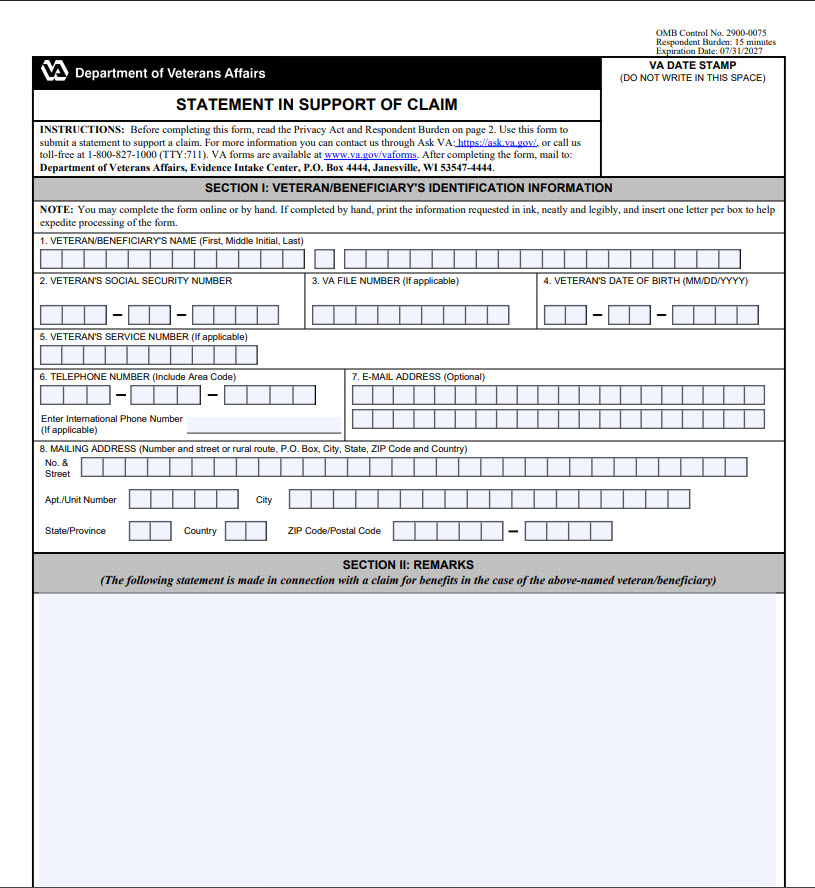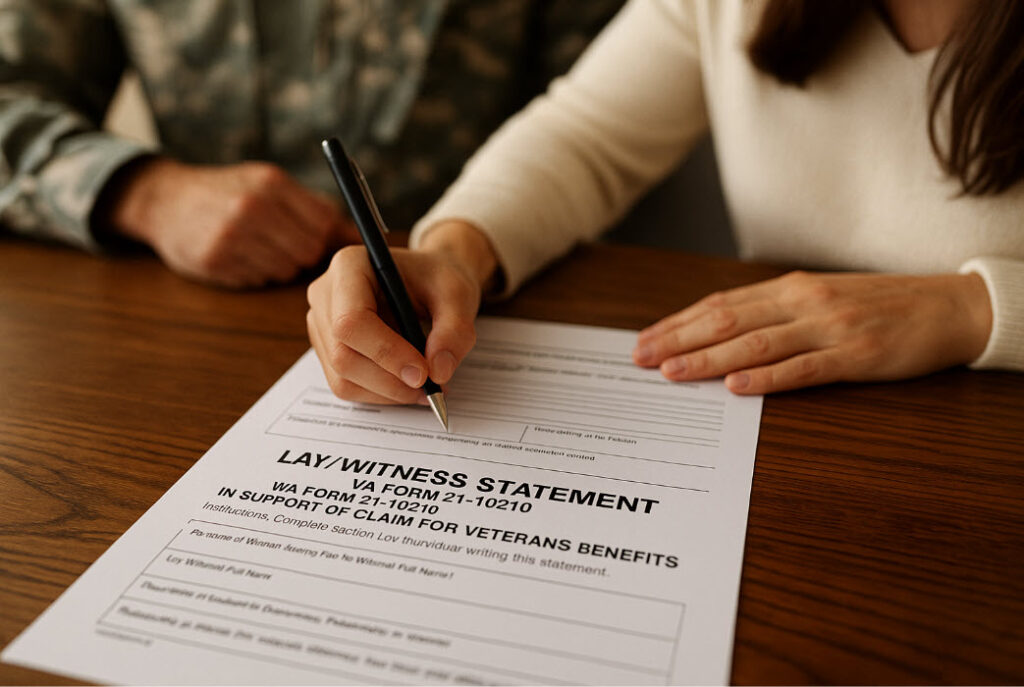April 19, 2025
0 comments
April 19, 2025
0 comments
By VetRoy
April 19, 2025
If you’re a veteran applying for VA disability compensation, your Statement in Support of VA Claim (VA Form 21-4138) can be one of the most powerful tools in your entire application. It’s your chance to tell your story — to explain in your own words how your service-connected condition affects your daily life, your work, your relationships, and your overall well-being.
This isn’t just paperwork. It’s your personal testimony. And when done correctly, it can mean the difference between approval and denial.
In this article, I’ll walk you step-by-step through how to write a compelling, complete, and credible statement that supports your claim and helps the VA understand your reality.
Tip:📌 Download the blank VA Form 21-4138 here. Use it as you read through this article.
Your statement gives context to the medical evidence. It answers the question that the VA benefit examiners ask as they consider your claim: “How does this condition "really" impact the veteran’s life?”
•PTSD and other mental health claims
•Tinnitus, migraines, and chronic pain
•Conditions without obvious external symptoms
•Situations where service records are incomplete or hard to access
•Understand the severity and frequency of symptoms
•Confirm the beginning and progression of your condition
•Match your words to medical and service records
•Gauge the credibility and consistency of your experience
Write as if you are speaking to someone who has never served, and who doesn’t know military lingo. Be specific, not vague.
Instead of: “I have a hard time sleeping.”
Write: “I wake up almost every night due to nightmares related to my time in Afghanistan. I average about 3–4 hours of sleep. This leaves me exhausted, irritable, and unable to focus at work.”
Describe the frequency, intensity, and impact of your symptoms. Use dates, examples, and concrete outcomes.
Also, use action verbs and avoid generalizations:
•Replace “bad” with “debilitating”
•Replace “sometimes” with specific frequencies: “twice a week,” “every morning,” etc.
The more you paint a vivid picture, the easier it is for the VA rater to see the connection.
Use this format to stay organized:
1. Introductory Paragraph
State your name, branch of service, time in service, and what you are writing about.
“My name is James Smith. I served in the U.S. Army from 2005 to 2011 and was deployed to Iraq twice. I am writing this statement to support my claim for service-connected PTSD.”
2. Describe the Incident(s)
Mention what happened during service that caused or contributed to your condition.
“During my second deployment in 2009, our convoy was hit by an IED. I lost two members of my unit. I still remember the sounds and the aftermath vividly.”
3. Explain the Symptoms and Effects
Share how the condition affects your life today.
“Since returning home, I have suffered from severe anxiety, panic attacks, and difficulty in crowds. I’ve isolated myself from family and have been unable to maintain steady employment.”
4. Summary and Statement of Truth
End with a clear statement affirming that the information is true to the best of your knowledge.
“I certify that the above information is true and correct to the best of my knowledge and belief.”


“My name is Michael Green. I served in the U.S. Marine Corps from 2006–2013 and deployed twice to Afghanistan. I am submitting this statement in support of my claim for service-connected migraines.
During my deployment, I was exposed to repeated concussive blasts from mortar fire and IEDs. Since returning, I have suffered chronic migraines that occur 3–4 times a week. These episodes cause intense pain, nausea, and sensitivity to light. I often have to lie down in a dark room for hours, missing work and family obligations. I have sought treatment multiple times from both VA and civilian neurologists.”
• Spouses or family members (known as “lay statements”)
• Fellow service members who witnessed the incident or symptoms
These add credibility and confirm details from another perspective. A supporting statement in support of VA Claim should be submitted using an additional form. 📄 Use VA Form 21-10210 for this purpose.

These statements should also follow a basic structure: identify who they are, their relationship to you, and what they have witnessed.
A lot of veterans make avoidable mistakes because of misinformation. Let’s clear a few things up:
MYTH: “The VA doesn’t read these.”
✔ FALSE. VA reviewers often rely on these to determine the severity of the condition and whether it’s service-connected.
MYTH: “If I already have a diagnosis, I don’t need this.”
✔ FALSE. Medical evidence shows what’s wrong — your statement explains how it affects your life.
MYTH: “It has to be typed.”
✔ FALSE. Neatly handwritten statements are acceptable, but typed documents are clearer and easier to process.
•Avoid exaggeration. Honesty builds credibility.
•Don’t rant against the VA, government, or policies. It may turn off a reviewer.
•Don’t include political commentary, grievances, or off-topic narratives.
Your story is powerful — let it speak for itself.
Before you submit your statement in support of VA claim:
•Read the statement aloud (helps catch awkward phrasing)
•Ask someone to read it — ideally, another veteran, advocate, or representative
•Review it against the checklist below.
✅ State your full name, branch, and service period
✅ Identify the condition and how it is service-connected
✅ Describe the original incident or exposure
✅ Explain current symptoms (frequency, severity, duration)
✅ Share how the condition affects work, relationships, and daily life
✅ Include buddy or lay statements if available
✅ Avoid exaggerations or unrelated commentary
✅ End with a truthful certification
Attach your completed statement to your claim packet or upload it via VA.gov. You can also:
•Deliver it in person to your regional VA office
•Submit it through an accredited representative
•Mail it to the appropriate VA intake center
📝 Always keep a copy for your records and document the submission date.
Remember: clarity and accuracy are key. A strong statement doesn’t need to be long, but it must be sincere and well-organized.
Writing your Statement in Support of VA Claim can feel intimidating. But with the right structure and support, it becomes a strong piece of your claim — one that can help win the benefits you’ve earned.
If you need help reviewing your statement, preparing supporting evidence, or just want a second opinion before you submit, schedule a free consultation. We will be happy to assist you. There is no fee to speak with us. You can also contact us at info@veteranbenefitssolutions.com
📅 Schedule Your Free VA Claim Consultation now!